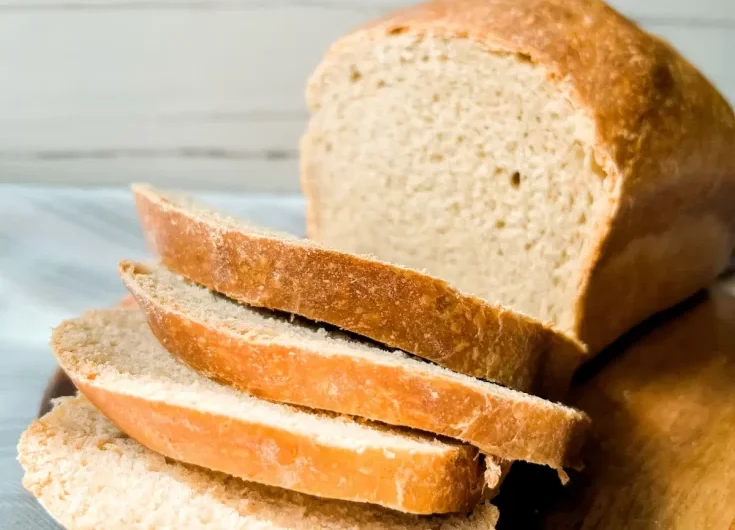Sourdough sandwich bread is a versatile staple that brings a delightful tang and softness to your sandwiches. Whether you’re a seasoned baker or just starting, mastering this recipe can elevate your culinary repertoire.
Tips for Making Perfect Sourdough Sandwich Bread
Use Soft Butter: Softened butter, cubed, integrates smoothly into the dough. Alternatively, you can use coconut oil for a dairy-free version, but ensure it’s softened, not melted.
Avoid Over-Fermentation: Over-fermenting the dough leads to a wet, sloppy mess that struggles to rise. While still edible, it may not yield the best bread. Consider repurposing it into sourdough croutons if this happens.
Utilize a Stand Mixer: A stand mixer makes the process more manageable and less hands-on. However, you can also knead the dough by hand if you prefer.
Why Sourdough Makes Excellent Sandwich Bread
Sourdough bread is a fantastic choice for sandwiches. Its tangy flavor enhances the taste of any filling. You can opt for a crusty sourdough loaf or this softer sourdough sandwich bread for a more delicate bite.
Troubleshooting: Why Isn’t My Sourdough Bread Rising?
Several factors can affect the rise of your sourdough bread:
Inactive Starter: An underactive or weak starter won’t give your dough the lift it needs. Ensure your starter is bubbly and active before using it.
Temperature: The rising environment’s temperature plays a crucial role. A cooler room will slow down the rising process. Aim for a warm spot for optimal rising.
Water Quality: Water that’s too hot can kill the starter, while chlorinated tap water can harm the yeast. Use room-temperature, non-chlorinated water for best results.
Health Benefits of Sourdough Bread
Sourdough bread is considered healthier than many other breads due to the fermentation process, which breaks down gluten and increases nutrient availability. This makes the grains easier to digest and the nutrients more accessible. Pair with healthy toppings for a nutritious, satisfying meal.
Essential Ingredients for Sourdough Sandwich Bread
Butter (or Coconut Oil): Butter adds a rich, savory flavor, while coconut oil works as a vegan substitute.
Honey (or Sugar): Honey acts as a natural sweetener, enhancing the bread’s flavor.
Salt: Essential for flavor. Skipping it results in a bland loaf.
Sourdough Starter: A ripe, bubbly starter is key to achieving fluffy bread.
Water: Room temperature water ensures the right environment for the starter.
All-Purpose Flour: Simple and effective, all-purpose flour works best for this recipe.
How To Make:
Preparing the Dough
Combine Ingredients: In a stand mixer bowl, add all ingredients, placing the flour last. Adjust flour quantity based on the starter’s hydration.
Knead the Dough: Knead until the dough is smooth, stretchy, and pulls away from the bowl’s sides, about 10 minutes. Perform the windowpane test: stretch a small dough piece into a square. It should become thin enough to see through without breaking.
Bulk Fermentation: Allow the dough to rise for 10-12 hours in a warm place. During warmer months, 8 hours may suffice. In colder months, longer fermentation might be necessary. Be cautious of over-proofing, which results in a wet dough.
Shaping the Loaves
Prepare the Pans: Grease two loaf pans or line them with parchment paper.
Divide the Dough: Split the dough into two equal parts.
Shape the Loaves: Roll each dough piece into a rectangle, then roll it up tightly and place it in the prepared loaf pans.
Second Rise and Baking
Second Rise: Let the loaves rise at room temperature for 2-4 hours until doubled in size. The duration depends on the room temperature and starter activity. This step is crucial for dough strength and volume.
Optional Egg Wash: For a golden-brown crust, brush the tops with an egg wash before baking.
Bake: Preheat the oven to 375°F (190°C) and bake for 45 minutes or until the loaves are golden brown.
Cooling: Allow the bread to cool completely before slicing. This ensures the texture is set and makes slicing easier.
Storing Your Bread
Room Temperature: Store in an airtight container for up to five days.
Freezing: Freeze loaves in freezer-safe bags for 3-6 months. Thaw at room temperature when ready to use.
Final Thoughts
Mastering sourdough sandwich bread combines patience and precision. By following these detailed steps, you’ll achieve a soft, fluffy, and flavorful loaf perfect for any sandwich.






